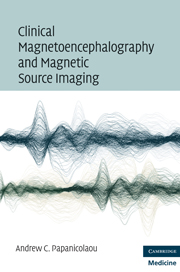Book contents
- Frontmatter
- Contents
- Contributors
- Preface
- Section 1 The method
- Section 2 Spontaneous brain activity
- Section 3 Evoked magnetic fields
- 19 Recording evoked magnetic fields (EMFs)
- 20 Somatosensory evoked fields (SEFs)
- 21 Movement-related magnetic fields (MRFs) – motor evoked fields (MEFs)
- 22 Auditory evoked magnetic fields (AEFs)
- 23 Visual evoked magnetic fields (VEFs)
- 24 Language-related brain magnetic fields (LRFs)
- 25 Alternative techniques for evoked magnetic field data – future directions
- Postscript: Future applications of clinical MEG
- References
- Index
22 - Auditory evoked magnetic fields (AEFs)
from Section 3 - Evoked magnetic fields
Published online by Cambridge University Press: 01 March 2010
- Frontmatter
- Contents
- Contributors
- Preface
- Section 1 The method
- Section 2 Spontaneous brain activity
- Section 3 Evoked magnetic fields
- 19 Recording evoked magnetic fields (EMFs)
- 20 Somatosensory evoked fields (SEFs)
- 21 Movement-related magnetic fields (MRFs) – motor evoked fields (MEFs)
- 22 Auditory evoked magnetic fields (AEFs)
- 23 Visual evoked magnetic fields (VEFs)
- 24 Language-related brain magnetic fields (LRFs)
- 25 Alternative techniques for evoked magnetic field data – future directions
- Postscript: Future applications of clinical MEG
- References
- Index
Summary
Overview of AEFs
AEFs to monaural or binaural stimulation have several advantages over auditory evoked potentials (AEPs) elicited in a similar manner. Unlike AEPs, AEFs can clearly and easily distinguish bilateral responses. Thus, any unilateral abnormality or interhemispheric difference between auditory cortices can be accurately detected. In addition, any abnormal auditory function can be quantitatively evaluated by variations in latency with or without amplitude attenuation.
AEFs can be used clinically to localize the auditory cortex and to evaluate auditory function in patients with (1) either organic or functional brain diseases before surgical interventions such as craniotomy, endovascular, or radiosurgical procedures, and/or (2) suspected abnormal conditions in the ascending pathways from the peripheral to the central auditory system.
Recording AEFs
AEF sources
For most clinical purposes, the M100 component of the AEF is analyzed. This component peaks on average at 90 ms after the onset of the stimulus at the subject's ear (in older children and adults) and corresponds to the vertexnegative N100 response in AEPs. Intracranial sources that account for the peak of the M100 response can be localized reliably in the supratemporal plane in the close vicinity of Heschl's gyrus. However, magnetic activity at and slightly after the M100 peak may be produced by anatomically distinct auditory cortex generators. Evidence from parallel intracerebral and MEG recordings showed that early portions of M100 activity coincide with electrophysiological activity inside Heschl's gyrus, whereas later activity may originate in the planum temporale.
- Type
- Chapter
- Information
- Clinical Magnetoencephalography and Magnetic Source Imaging , pp. 134 - 137Publisher: Cambridge University PressPrint publication year: 2009



